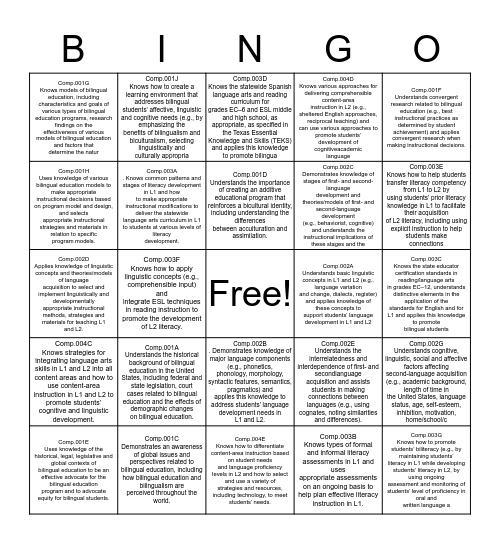

This bingo card has a free space and 24 words: Comp.001A Understands the historical background of bilingual education in the United States, including federal and state legislation, court cases related to bilingual education and the effects of demographic changes on bilingual education., Comp.001C Demonstrates an awareness of global issues and perspectives related to bilingual education, including how bilingual education and bilingualism are perceived throughout the world., Comp.001D Understands the importance of creating an additive educational program that reinforces a bicultural identity, including understanding the differences between acculturation and assimilation., Comp.001E Uses knowledge of the historical, legal, legislative and global contexts of bilingual education to be an effective advocate for the bilingual education program and to advocate equity for bilingual students., Comp.001F Understands convergent research related to bilingual education (e.g., best instructional practices as determined by student achievement) and applies convergent research when making instructional decisions., Comp.001G Knows models of bilingual education, including characteristics and goals of various types of bilingual education programs, research findings on the effectiveness of various models of bilingual education and factors that determine the natur, Comp.001H Uses knowledge of various bilingual education models to make appropriate instructional decisions based on program model and design, and selects appropriate instructional strategies and materials in relation to specific program models., Comp.001J Knows how to create a learning environment that addresses bilingual students’ affective, linguistic and cognitive needs (e.g., by emphasizing the benefits of bilingualism and biculturalism, selecting linguistically and culturally appropria, Comp.002A Understands basic linguistic concepts in L1 and L2 (e.g., language variation and change, dialects, register) and applies knowledge of these concepts to support students’ language development in L1 and L2, Comp.002B . Demonstrates knowledge of major language components (e.g., phonetics, phonology, morphology, syntactic features, semantics, pragmatics) and applies this knowledge to address students’ language development needs in L1 and L2., Comp.002C Demonstrates knowledge of stages of first- and second-language development and theories/models of first- and second-language development (e.g., behaviorist, cognitive) and understands the instructional implications of these stages and the, Comp.002D Applies knowledge of linguistic concepts and theories/models of language acquisition to select and implement linguistically and developmentally appropriate instructional methods, strategies and materials for teaching L1 and L2., Comp.002E Understands the interrelatedness and interdependence of first- and secondlanguage acquisition and assists students in making connections between languages (e.g., using cognates, noting similarities and differences)., Comp.002G Understands cognitive, linguistic, social and affective factors affecting second-language acquisition (e.g., academic background, length of time in the United States, language status, age, self-esteem, inhibition, motivation, home/school/c, Comp.003A . Knows common patterns and stages of literacy development in L1 and how to make appropriate instructional modifications to deliver the statewide language arts curriculum in L1 to students at various levels of literacy development., Comp.003B Knows types of formal and informal literacy assessments in L1 and uses appropriate assessments on an ongoing basis to help plan effective literacy instruction in L1., Comp.003C Knows the state educator certification standards in reading/language arts in grades EC–12, understands distinctive elements in the application of the standards for English and for L1 and applies this knowledge to promote bilingual students, Comp.003D Knows the statewide Spanish language arts and reading curriculum for grades EC–6 and ESL middle and high school, as appropriate, as specified in the Texas Essential Knowledge and Skills (TEKS) and applies this knowledge to promote bilingua, Comp.003E Knows how to help students transfer literacy competency from L1 to L2 by using students’ prior literacy knowledge in L1 to facilitate their acquisition of L2 literacy, including using explicit instruction to help students make connections, Comp.003F Knows how to apply linguistic concepts (e.g., comprehensible input) and integrate ESL techniques in reading instruction to promote the development of L2 literacy., Comp.003G Knows how to promote students’ biliteracy (e.g., by maintaining students’ literacy in L1 while developing students’ literacy in L2, by using ongoing assessment and monitoring of students’ level of proficiency in oral and written language a, Comp.004C Knows strategies for integrating language arts skills in L1 and L2 into all content areas and how to use content-area instruction in L1 and L2 to promote students’ cognitive and linguistic development., Comp.004D Knows various approaches for delivering comprehensible content-area instruction in L2 (e.g., sheltered English approaches, reciprocal teaching) and can use various approaches to promote students’ development of cognitiveacademic language and Comp.004E Knows how to differentiate content-area instruction based on student needs and language proficiency levels in L2 and how to select and use a variety of strategies and resources, including technology, to meet students’ needs..
Bilingual Competencies | Danielson Bingo | McREL BINGO | McREL BINGO | TRDV 400 Bingo
Share this URL with your players:
For more control of your online game, create a clone of this card first.
Learn how to conduct a bingo game.
With players vying for a you'll have to call about __ items before someone wins. There's a __% chance that a lucky player would win after calling __ items.
Tip: If you want your game to last longer (on average), add more unique words/images to it.